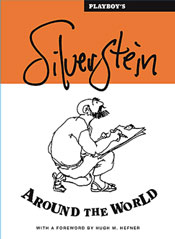
Playboy’s Silverstein Around the World
by Shel Silverstein, Hugh Hefner and Mitch Meyers
Fireside

Even if we live in a world where it seems that we’re all interconnected, there are still parts of our lives that remain separate until something forces them to collide, throwing us into a twisting whirlwind of elation, nostalgia, and confused wonder. And when Playboy decided this June to release the travelogues of the late Shel Silverstein–which appeared in Playboy between 1957 and 1968–I was excited to discover an early part of Silverstein’s work I didn’t know existed beyond Where the Sidewalk Ends, A Light in the Attic, and The Giving Tree. In true wtf fashion, I sat with this book in my hands thinking how weird and awkward it was to see Playboy and Shel Silverstein on the same cover.
Much of my confusion was a result–like many kids reared in the eighties–of having my mom read The Giving Tree to me circa the 1st grade and then as I got older, like most adolescent boys, pushing aside the timeless story about selflessness and eventually being introduced to the alluring and glossy females of Playboy magazine. Yes, of course, I never read the articles and Around the World has made me realize that I unknowingly absorbed the post-_The Giving Tree_ work of one of my favorite authors. Now, as an adult, I’ve had the pleasure of being reintroduced to the early and formative side of Shel Silverstein that I never knew existed.
In the foreword, Playboy founder Hugh Hefner recalls the first moments when he encountered Silverstein and his sketches in Playboy’s Chicago Headquarters in 1956, shortly after Silverstein’s return home after working with Armed Forces publication Stars and Stripes. “He dropped off his drawings and I didn’t get around to them and a couple of weeks later he came back demanding his cartoons back….There were about fifteen drawings and I laid them out on my desk. How’s five hundred, six hundred dollars? I asked, Shel nodded his head with a bit of uncertainty.” Hefner goes on to explain how he had to talk Silverstein into doing the travel assignment and how Silverstein was unsure and doubtful about putting himself at the center of the travelogues.
Following Hefner’s foreword, Silverstein’s nephew Mitch Meyers introduces his uncle, explaining the scope of Silverstein’s work that extended far beyond the Playboy articles into songwriting, screenwriting, and eventually snowballing with the success of The Giving Tree in the early sixties. For most of his life, Silverstein kept residence in New York but had made numerous connections in the music and film industries and was the songwriter for Johnny Cash’s “A Boy Named Sue” and co-writer with David Mamet for the screenplay “Things Change.”
Along with background on how Silverstein developed his simplistic yet reflective sketch style, one of the most impressive insights that Meyers explains is how Silverstein was able to infuse his pieces with a unique sense of wry humor. Silverstein gave his sketches a rare depth of humanity which Meyers says was fueled by a desire to present a more human side of sexuality by not taking himself, or culture, too seriously, and by being honest about how he felt in the situations he was capturing.
The slick 150-plus pages of original Playboy sketches and articles are a chronicle of Silverstein’s journey to the 22 locations, showing a lesser-known side of Silverstein that adds depth to his children’s books. Rare photographs capture his musical prowess with Geisha in Japan and reproduced sketches show him fielding questions in a Paris café about the true state of the American female sexual identity in the 1960’s. Foreshadowing the childlike innocence of The Giving Tree, he chronicles the fulfillment of his childhood dream of playing ball with the White Sox in “Silverstein Plays Ball.”
As you flip through Around the World, you quickly realize where the resonance within his children’s books comes from. Silverstein makes the book read like a brief prequel to an artistic graphic biography of how an artist came into his own as each Playboy cartoon and sketch displays Silverstein’s creative progress. And though Silverstein never married before he died in 1999, having been a lifelong bachelor, he always maintained his undeniable talent for expressing extremely deep and universal human emotions with his drawings. Whether he was perusing the streets of Haight and Ashbury with the Hippies in 1968 or going deep into the heart of Russia and sketching the guards at the Kremlin in 1958, he always astutely captured the American stereotype and turned it into a profound moment of poetry.
Like a good road novel, Around the World makes you want to travel to those same places. But most of all it demands a revisiting of The Giving Tree and Silverstein’s poetry. It’s also got me thinking a little bit down the line. And even though I don’t have kids of my own just yet, I know that whenever the time does come for me to crack open The Giving Tree as a parent, I will have to rethink how, exactly, I’m going to explain the creative coexistence of Shel Silverstein and Playboy magazine–two icons that are almost unavoidable when you grow up in America, and rarely mentioned in the same sentence or presented on the same page.
Fireside: http://simonsays.com












